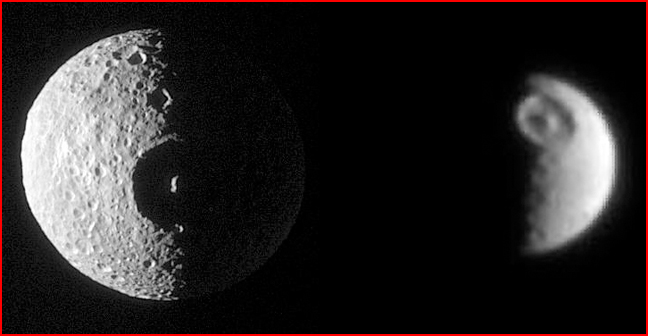
home •
about •
essential guide •
picture of the day •
thunderblogs •
news •
multimedia •
predictions •
products •
get involved •
contact
picture of the day archive subject index
Credit: NASA/JPL/Space Science Institute
Jun 08, 2007
Holes in Moons … and in TheoriesThe impact theory of crater formation may not survive the discovery of gigantic craters on relatively small moons or rocks. A good case in point is Saturn’s moon Mimas. Electric Universe proponents say that only electric discharge could produce the observed depression without shattering the moon.
How do you make a 138 km hole in a 392 km ball of ice? If you’ve spent your life reading textbooks in astronomy, the answer is obvious: You smash a smaller body into the ball of ice at an unearthly high speed.
The textbooks show pictures of circular holes created in laboratory settings from the impacts of bodies moving at earthly high speeds. The holes have rounded bottoms and sides; sometimes they have a hump of debris in the center that rebounded from the impact. Scale up the lab bullet to the size and speed of an asteroid, and you have the big hole in the ice ball.
The 138 km hole on Mimas (image above), a satellite of Saturn, like similar holes on the Moon, has a flat bottom and steep sides and a steep pillar in the center. The rim is more “pinched up” than “thrown out”, and there are small holes all along it. The textbooks explain that the shape and features are different from lab impacts because the much higher—unearthly—speeds of cosmic bodies bring a different physics into play. So the experimental physics that proves the hole on Mimas to be an impact site is not the physics that actually created the hole.
The density of Mimas is about that of water, so Mimas must be mostly ice, astronomers tell us. The strength of ice isn’t all that much, while the energy of the impact was surely “that much” and more. The experiments with impact cratering suggest that the unearthly speed of the body claimed to have hit Mimas must have almost shattered it. But Mimas wasn’t shattered, so the different physics that produces the different shape of the hole must also have a selectively restrained effect on ice.
If astronomy were a science, astronomers would examine as many novel explanations as feasible with available time and resources. One such novel explanation is that of the Electric Universe: No impact ever threatened to shatter Mimas’ cohesive forces. Instead there were sharply limited pulling forces—a pair of Birkeland vortices rotating around an axis between them, electrically cutting away the material in their path and lifting it into space. The appropriate model is not a lab impact but industrial electrical discharge machining (EDM). When a lab discharge is limited to producing a single isolated spark, it creates a crater with exactly the features of cosmic craters—flat floor, steep sides, central peak.
The central spire is the material left where the vortices didn’t quite touch each other at the axis. The flat floor is the evenly machined surface that is sought in industrial uses of EDM. The steep sides and “pinched up” rim are where the electrical cutting force dropped off at the edges of the vortices. The small craters around the rim are where secondary arcs struck the highest points as the discharge quenched.
It doesn’t matter what Mimas is made of. EDM will cut a crater in ice, rock, or metal. That’s why craters on planets, moons, asteroids and comets—and EDM surfaces—all look the same. That’s why the impact theory inevitably resorts to ad hoc excuses when different materials experimentally respond to impact in ways that contradict our observations in space.
It is true that the electrical machining hypothesis requires a giant conceptual leap from the direction of prior theory. But when prior theory no longer works, a giant conceptual leap is exactly what is needed. We must stop thinking of planetary history in the uneventful terms once imagined by astronomers. The space age shattered the notion with pictures that do not lie.
___________________________________________________________________________Please visit our Forum
The Electric Sky and The Electric Universe available now!

|
|

|
EXECUTIVE EDITORS:
David Talbott, Wallace Thornhill
MANAGING EDITORS:
Steve Smith, Mel Acheson
CONTRIBUTING EDITORS: Michael Armstrong, Dwardu Cardona,
Ev Cochrane,
C.J. Ransom, Don Scott, Rens van der Sluijs, Ian Tresman
WEBMASTER: Brian Talbott
Copyright 2007: thunderbolts.info
![]()
home •
thunderblogs •
forum •
picture of the day •
resources •
team •
updates •
contact us

